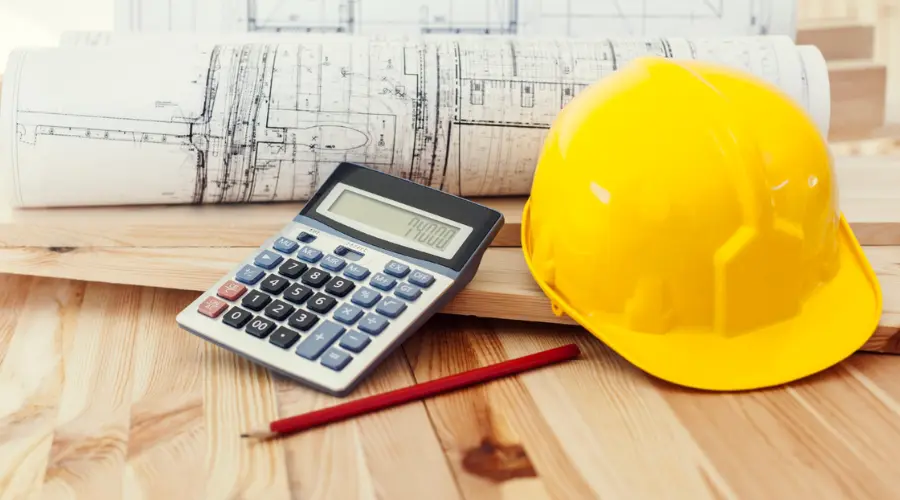About to start your construction project, but don’t know how to calculate its cost? Don’t worry, in this blog, we’ll discuss every aspect of construction costs, highlighting important factors and the methods to ensure perfection in conducting cost estimates. Construction cost estimating is known as the process of calculating all the costs, expenses, and expenditures associated with your construction project. This includes estimating all the direct and indirect costs to ensure that your construction project finishes within the specified budget and on time.
The construction cost estimation process requires detailed and expert knowledge of all the materials, resources, equipment, along labor required for the project. You would need to estimate the cost of every aspect of your project to ensure your project’s success without any financial issues.
Importance of Accurate Cost Estimating
As we know, constructing a building, house, commercial, or any industry-level sector isn’t very easy unless you have the required knowledge of your project. Cost estimation is an important part of your construction project, as uncertainty in project costs will cause significant project cost or budget overrun, which will create more problems. Some projects that face extreme budget overruns often shut down.
Research shows that more than 30% of the project cost or budget overruns are the direct result of poor cost estimations. More than 61% of contractors also agree with the fact that incorrect cost estimating and budgeting can lead to project delays. Accurate and error-free cost estimating is crucial as it ensures that your construction project doesn’t face any issues such as cost overruns, project delays, resource over-purchase, and more. But how to do it? Our construction estimating guide has all your answers.
Factors Affecting Cost Estimates
The calculation of the price of your building work project could come to depend on several variables like the extent of the building project, the degree of design, the cost of the commodity in the market, the location of the project, labour, material, or equipment, just to mention a few. Knowledge and skills in conducting decent research can allow you not only to obtain approximate costs and expenses but also ensure the highest level of budgeting and financial planning.

- Project Scope and Size 6. Site Location and Conditions
- Design Complexity 7. Legal and Regulatory Factors
- Material Costs 8. Project Management and Supervision
- Labor Costs 9. Overheads and Indirect Costs
- Equipment and Tools 10. Contingencies and Risk Allowances
Process for Conducting Construction Cost Estimations
When it is about estimations for construction projects, one must always focus on achieving accuracy to ensure no issues in the future. Which is why you should always follow a smooth, streamlined, and well-structured process and strategy to ensure results that are beneficial and meet the quality standards. By following the provided process, you can conduct estimations flawlessly.
- Reviewing & Understanding Project Details
First, you must have all the information regarding your construction project. This includes ensuring all the designs, drawings, blueprints, models, specifications, and requirements. You can also document these things to ensure that nothing is missed.
Using your project design, it is easy to know about what materials, resources, equipment, systems of mechanical nature, plumbing, electrical, insulation, fire-resistance, waterproofing, and others will be needed in your project, and hence, you can easily estimate the costs.
In this step, site visits are also a crucial step as some construction projects, such as concrete slab installation, gardens, swimming pools, and other projects, need a soil check. However, a site check or visit is not compulsory, but for a beginner, it helps in a better understanding of your project site and all the costs associated with it.
- Conduct Quantity takeoffs
When you have a clear idea and all the knowledge of your project details and requirements. You can now start working on material estimation and quantity takeoffs. Estimators utilize documentation and count all the items, materials, or resources such as concrete, wood, clay, steel, wood, bricks, glass, and more required for your project. You also have to evaluate the equipment required for your construction project, along with the labor required for each task. The managers, engineers, workers, and other members of the workforce are to be calculated in this step.
- Create a Bill of Quantities
Bill of Quantities is a document that provides project managers with a detailed list of materials, labor, and equipment required for their project along along with the costs associated with them. Using this can help track and check the project’s costs, progress, and inventory efficiently.
It is basically what is needed and how much, and it is the second thing you should do after quantity takeoffs. A well-prepared BoQ can enhance your communication with vendors, support procurement decisions, and ensure precise cost tracking throughout the project lifecycle. It acts like a central reference for project managers and estimators do the following:
- Track material quantities and prices
- Monitor labor requirements and costs associated
- Forecast equipment usage and rental fees
- Maintain budget control and prevent overspending

- Discuss the prices with suppliers & vendors
The fourth step is where the cost estimation process actually starts. Basically, it includes conducting a full analysis of your local market and contacting multiple suppliers to achieve the best price deal. This detailed analysis can help you access all the latest market rates and costs, allowing you to keep your database up-to-date.
- Evaluate your workforce and their cost
Now you start working on your labor and staff team. You estimate all the labor required for the construction of your sector, including the project managers, engineers, designers, and other stakeholders. Calculate the costs and wages for each professional. This will help you maintain your team expenditures, making sure that you are not overpaying or hiring labor more than required. You should also make sure that your labor expenditures are within budget.
- Overheads, Legal Fees, Indirect Cost Analysis
Calculate the costs such as overheads, storage, machinery maintenance fees, training, electricity, water, legal fees, charges, security fees, salaries, rental fees, and more associated with your construction project.
It is essential to assess all legal, regulatory, insurance, taxes, and compliance fees associated with your construction project to prevent future compliance complications.
- Evaluating Cost For Contingencies
Are you aware that there are over 900,000 construction-related business operations in the US alone, and the construction business does almost 2.1 trillion dollars worth of structures annually. Most of these projects usually do not succeed to the extent of miscalculating the costs, which subsequently lead to problems like delays, overruns, wastage of resources, shortage of labor, etc.
Smart construction project management teams often conduct risk analysis to find unexpected issues and risks that might negatively impact their project objectives and scopes. Companies often reinvest some percentage of their generated profit, and some profit is reserved to deal with issues that might arise unexpectedly.
- Organizing The Estimates
When all the building construction cost data is evaluated, calculated, and estimated properly. You should organize your estimates properly. Many estimators and professionals utilize spreadsheets for organizing their estimates. This helps in better communication between project owners, managers, stakeholders, and other members and allows them to use the document efficiently.
For contractors or firms bidding on a project, looking forward to bid preparation, after completing and organizing your cost estimates, compile a professional bid proposal that includes all the estimated costs, project timeline, goals, terms, conditions, contract clauses, payment, and other necessary details.
We have discussed the steps for conducting construction cost estimates in detail; following them can help you achieve your goals without any difficulties or problems. But there is one thing: how do we ensure precision and accuracy in the cost estimates? Now, we shall discuss the techniques and strategies to ensure a smooth construction cost estimation process.

Techniques for Accurate and Precise Estimations
Do you know that projects that utilize imprecise and unreliable cost estimates, which are due to poor estimation techniques utilized, often see an increase in project costs by 27%. There are many ways you can prevent errors and issues in your cost estimation. Here are some of the best construction cost estimation techniques and strategies to achieve perfection in your cost estimates.
Use Of Estimating Software:
There are multiple professional construction estimating software programs out there, such as ProEST, PlanSwift, Bluebeam Revu, Procore, SAGE, and more, that can help you conduct your cost estimation process without any issues or problems. Software tools to analyze 3D and 2D models are also available. Autodesk Revit, Autodesk Navisworks, Trimble Vico Office, CostX, Autodesk Construction Cloud tools, Procore, etc, these software have everything you require for top-notch BIM cost estimating.
Maintain Your Database:
You need to put in place a form of guarantee that your database is updated with the latest market rates, trends, guidelines, rules, codes, and regulations. To get the best possible price rates for your material, labour, and equipment needed to carry out the project, careful market analysis and vendor and supplier consultation can be applied.
Categorize and Organize Your Documents:
Creating a well-organized document that highlights all the materials, resources, items, and equipment that everyone can easily understand and identify things efficiently. Without properly arranged documentation, your project owners, stakeholders, managers, and team members cannot be fully satisfied. If you have a messy document, mistakes and issues can happen even if your evaluations are perfect.
You can also download or use a construction cost estimate example template to simplify and make budgeting as well as planning for your residential or commercial construction projects much easier. Such a template often includes sections for project details, a breakdown of direct and indirect costs, and overall cost summaries.
Historical Data Comparison:
Preliminary estimating is one of the most common and well-used strategies. It includes bringing in the use of historical and similar data from previous projects for comparison. The project construction team often uses them to forecast prices, requirements, and risks that the current project may also face. This method gives you a full and clear idea of the expenses, expenditures, and all the costs that are associated with your project, which can be useful if you are about to start the project.
Estimates According to Standards:
Professional estimating companies focus on delivering cost estimates that not only meet the requirements and specifications of their project but also meet the best quality standards. To ensure this and maintain trust, it is better to comply with the guidelines and standards such as ASTM, AACE, ISO, RICS, and more.
Best Software Estimating Tools Available
Wondering how to ensure efficiency in the cost estimating process? Bring in the use of specialized and professional software equipment, which allows multiple features and can help you smooth the process. The following tools include almost every feature that you would require for your estimation project. From quantity assessments to complex calculations, you can easily manage your cost estimations. Most tools also support AI, so you are expecting automatic, complex evaluations to be resolved efficiently.
RSMeans Data: It is North America’s premier construction estimating software that allows multiple features and functionalities, which makes the life of estimators easy. You can utilize this to ensure accurate cost estimates, allowing your projects to remain within budget and complete on time. RSMeans Data is also known as one of the best online building cost estimators.

• Key Points:
- It allows access to a cloud-based server with an up-to-date database of material, labor, and equipment costs with location adjustments for over 970 regions.
- Provides unit pricing, customizable estimates, and assemblies, ensuring precise project budgeting and bidding.
- Forecasting, historical data comparison, remodeling estimating, and more functionalities are available for use.
• Subscription Plan:
- Core – $2,268 Per Year
- Complete – $3,900.65 Per Year
- Complete Plus – $4,929.15 Per Year
It also offers a free trial along with custom purchase options, allowing you to optimize your subscription plans.
Buildxact: Also known as one of the best home remodeling estimating softwares out there, providing comprehensive features that help streamline every aspect of your construction project management. Its focus on automation, scheduling, job management, invoicing, and project estimating makes it a reliable and useful software tool for efficient management of your construction project.
• Key Points:
- Blu is an AI-powered digital building assistant that can help you with accurate estimating, error-checking, managing digital plans, creating estimates from scratch, and more.
- It connects you with Xero accounting software to ensure streamlined operations.
- Allows cloud-based estimating with real-time prices for materials, labor, and equipment..
• Subscription Plan:
- Foundation – $169 Per Month ( Billed annually at $2,030 )
- Pro – $339 Per Month ( Billed annually at $4,070 )
- Master – $509 Per Month ( Billed annually at $6,110 )
Buildxact also offers a 14-day free trial, allowing you to explore the software before paying for it.
ProEST: It is one of the top construction bidding softwares, developed by RIB Software AG. It is a construction estimating software used to conduct estimation, calculation, evaluation, and other project management processes efficiently. Many professionals, estimators, and contractors utilize this software tool for its outstanding performance. You can also import BIM data to generate model-based estimates.
• Key Points:
- It offers customizable templates, an intuitive and user-friendly navigable interface, created to optimize and enhance the user experience.
- ProEST is a well-known cloud-based bidding platform where you can access and manage bids anytime, anywhere online.
- The software is also known for its vast internal cost database system, which ensures accuracy and precision in project estimates.
• Subscription Plan:
- ProEST doesn’t offer a specific subscription plan, but you can get a quote and discuss pricing depending on your requirements. However, their pricing starts from $5000, depending on the software tool you are looking to purchase.
STACK: Developed by STACK construction technologies, is a well-known cloud-based estimating system that allows estimators to conduct quantity takeoff and estimation processes efficiently without any issues. It is also one of the best free construction estimating apps, providing a lot of features, functions, and options that can potentially help estimators conduct the estimation process without any errors, issues, or difficulties. If you are looking for the best yet free estimating softwares, this is what you want.
• Key Points:
- Consists of a pre-built and up-to-date database, where you can select materials, items, etc, and it creates your estimates by determining the amount of materials required and factoring in labor, equipment, and overhead costs.
- It offers more advanced features like integrations, unlimited projects, and reporting at an advanced level, but these are available in paid plans.
- It is fully online and cloud-based, allowing you to access to utilize your estimates at any time, anywhere…
• Subscription Plan:
- TakeOff and Estimate – $2,999 ( Per User and Year )
- TakeOff and Estimate – $2,999 ( 2+ User and Per Year )
STACK also offers other programs, such as “Build and Operate,” and their “Full STACK Platform” is also available. You can contact their team to discuss your requirements and pricing.
CostOS: In a search for an efficient and reliable tool to deliver results for your project? Developed by Nomitech, it is another most advanced cost estimating software available that helps estimators conduct quantity takeoffs, cost estimations, documenting, and many more with ease.
• Key Points:
- Like ProEST and Procore, it also supports BIM estimating and generates fast estimates using 3D models and predefined quantities.
- Offers integration capabilities that allow it to connect to and exchange data with other ERP systems, ensuring smooth and streamlined data exchange.
- Focuses on managing and storing cost data in one system, allowing accessibility from anywhere, making information maintenance easy and consistent.
• Subscription Plan:
- Foundation – $169 Per Month ( Billed annually at $2,030 )
- Pro – $339 Per Month ( Billed annually at $4,070 )
- Master – $509 Per Month ( Billed annually at $6,110 )
It currently doesn’t offer any free trial, and Like ProEST, it also doesn’t offer a specific pricing plan. Although their starting price is $2800, one time. You can request a quote and contact the team to discuss pricing.
Excel: Although Microsoft Excel is not a dedicated estimating software, but is a widely used tool for construction estimating, scheduling, budgeting, cost tracking, database, and many other things. Contractors, project managers, and estimators usually create custom spreadsheets or use templates to calculate material, labor, and equipment costs.
• Key Points:
- Users can utilize tailored templates for multiple project types, such as residential, commercial, and remodeling. It also offers multiple construction schedule template Excel for better planning.
- Functions, macros, and pivot tables help with fast calculations, evaluations, and reducing errors.
- You can import/export data to estimating software such as ProEST, RSMeans, and other project management platforms.
• Subscription Plan:
- Microsoft 365 Personal Plan – $6.99 Per Month
- Microsoft 365 Personal Plan – $12.50 Per Month
Although limited, but a free version of Excel via Microsoft 365 web.
Books For Guidance
Another way to understand how construction estimating and other aspects, such as bidding, are performed is through construction estimating books published by well-known and experienced authors. These books include a step-by-step process of construction estimating, techniques, strategies, nd how to do bid preparation, cost analysis, BIM integration, scheduling, project coordination, and much more.
Some Of The Books Are Listed Below:
| Author | Includes |
| RSMeans Estimating Handbook | Presented by RSMeans. It includes technical data required for the estimation of costs for major construction projects. |
| Estimating in Building Construction | Presented by Steven J. Peterson & Frank R. Dagostino. It is a step-by-step process of construction estimating. |
| Construction Estimating Using Excel | Presented by Steven J. Peterson. It includes all the practical estimating techniques using Excel templates, formulas, and functions. |
| BIM and Construction Management | Presented by Brad Hardin & Dave McCool. It includes a full guide and methods to integrate BIM for estimating, scheduling, project coordination, and management. |
| Fundamentals of Construction Estimating | Presented by David J. Pratt. It highlights all the estimating methods, bid preparation, cost analysis, and more. |
Construction Cost Per Square Foot
Construction Cost Per Square Foot means the expense and cost of constructing one square foot of building area. Whether you are looking to construct residential, commercial, or industrial-level sectors, the cost of construction per sq ft depends. Although it is a common way to measure and compare building costs during early stages, which include feasibility studies, requirement specification, or budgeting.
Residential: Do you know that residential construction in the US has been increasing by a big percentage, with single-family home production exceeding more than a million units annually. This was in both 2022 and 2023. More than 438,500 units were built last year, the highest apartment construction rate since 1987. Constructing your own residential sector is a significant task, and it should be handled perfectly. But do you know the cost of residential construction per square foot?
| Standard single-family | Cost per sq ft: $150 – $160 |
| Single-family (including overhead) | Cost per sq ft: $194.99 |
| Mid-range home | Cost per sq ft: $170 – $219 |
| High-end or Luxury home | Cost per sq ft: $220 – $399+ |
Commercial: Commercial construction cost per sq ft also depends upon various factors such as project size, scope, materials required, labor, etc. But if you are looking to construct your hotels, retail, education, health, or any other kind of departments, here’s how much it will cost you per square foot.
| Office ( Single-story to High-rise) | Cost per sq ft: $240 – $999+ |
| Retail ( Strip malls to Regional malls ) | Cost per sq ft: $260 – $550+ |
| Hotels ( Standard to Luxury ) | Cost per sq ft: $180 – $560+ |
| Education ( Standard to laboratories ) | Cost per sq ft: $300 – $840+ |
| Healthcare ( Medical offices to Hospitals ) | Cost per sq ft: $450 to $999+ |
Industrial: This is due to multiple reasons, such as simplified designs, reduced overhead costs, and repetitive design. Larger projects also allow for a larger volume of purchasing of materials and resources, leading to lower material costs.
| Warehouse ( Small to Large ) | Cost per sq ft: $85 – $139+ |
| Light Manufacturing | Cost per sq ft: $150 – $240+ |
| Large-scale Labs | Cost per sq ft: $350 – $1,200+ |
| Factories | Cost per sq ft: $142 – $1,270+ |
Which is better? Hiring a team or doing it yourself
For cost estimation, whether to hire professionals or do it yourself depends upon various factors such as the size, complexity, scope, along your personal experience.
If you hire a professional team of estimators, that will significantly help reduce errors and issues as experts utilize advanced software tools such as ProEST, STACK, SAGE, RSMeans, and more. Professionals also have experience in small as well as large-scale projects, giving them an upper hand if you are a beginner or don’t have experience in the specific industry.
Although hiring a professional has a downside, which is their fees. The general cost of estimators for small projects is around $100, but when it comes to large-scale projects, it exceeds $1000, and more. Full-time estimators’ salaries can also range from $40,000 to $80,000 annually.
Doing the cost estimations yourself can help avoid estimator fees, and you will have full control over everything. It is more suitable to do it yourself if your project is small or simple. Although it does have drawbacks, since miscalculations, limited tools, and time can weaken the process.
In the end, if you have small projects, you should do it yourself, but when it comes to large projects, hiring professionals is a better option.

Conclusion
In this blog, we have discussed how to find construction cost, guide, the best software estimation tools, factors affecting costs, costs of projects [per sq foot, and more. Whether you are looking forward to conducting cost estimations for your residential, commercial, or industry-level projects, through our blog, you can easily conduct the cost estimation process without any issues, difficulties, or any kind of problems.
FAQs
How do I estimate labor costs?
To calculate labor costs, you must know the amount of labor required for your construction project. Conducting an in-depth analysis of your location-specific market can help you stay updated on the costs. You must evaluate based on tasks, required skill levels, number of workers, daily wages, and project duration for which they will be required.
What are the best estimation tools?
Software estimation tools such as PlanSwift, Bluebeam Revu, Procore, PlanSwift, Autodesk Revit, SAGE, and more are used for the cost estimation process, while software such as Excel is widely used for documentation purposes.
How do poor estimates impact my construction project?
Poor cost estimations often consist of inaccurate quantity takeoffs and prices, which could lead to poor budgeting and resource management. The project might face material over-purchases, resource wastage, budget overruns, project delays, and many more problems that can damage the project objectives, scope, and vision.
Can I estimate construction costs without a contractor?
Yes, you can still estimate construction costs without the need for a contractor, but it depends on your skills. Working with an estimator or contractor helps improve accuracy, ensuring nothing is missed and no errors happen. Doing it yourself without the perfect skill and knowledge can risk the entire project.
What is the difference between indirect and direct costs?
Direct costs include materials, labor, and equipment, while indirect costs include permits, insurance, overhead, legal fees, and more. Both of them should be considered while estimating project cost.

